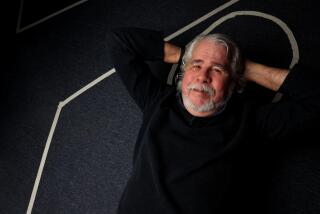ILLUMINATING THE IRISH
“If you want to understand the Anglo-Irish literature that came out of the middle of the 19th Century and afterward, whether it’s O’Casey or O’Neill or Brian Friel, you may understand the universals, but you’ll never know the specifics if you don’t know what Ireland suffered from the famine.”
Brian Heron, artistic director of An Claidheamh Soluis, Los Angeles’ three-month old Irish theater which attempts to illuminate the Celtic-Irish experience, was referring to the evocations of Thomas Murphy’s “Famine” (opening Saturday).
“It’s a play that deals with the great potato famine of 1846 and how that led to the destruction of village life--and even, to some degree, the language,” Heron said. “It parallels in many ways the Jewish Holocaust. But in this case Catholicism and absentee landlordism held the people down. There were other rich crops the Irish could’ve eaten, but those crops went to the payment of their rent as tenant farmers. A lot of the bitterness we see in the Irish character today carries from those days--so many died in the migration to America that the ships carrying them were called ‘coffin ships.’ That period made an indelible stamp on the Irish character.”
Heron’s Celtic center is more than a theater venue. “We give workshops in language and music--Scottish, Welsh and Breton, among others. We invite ethnic groups to intermingle. ‘The Famine’ is only one thing that took away food for thought. There’s a great danger to people when their ethnic identity is obliterated.”
One of the paradoxes of contemporary American society is that while it charges on hellbent in its mania for youth, there’s never been a period when it had to make more accommodations for the populous aging. Warehousing the elderly in convalescent homes, despite periodic documentaries on the subject and concerned editorials, remains one of our acute, embarrassing social dilemmas and is the subject of a new work by Marion Wagman called “The White Seal Coat,” opening Wednesday at Theatre Exchange.
“The White Seal Coat” is a co-production between Theatre Exchange and the Theatre of N.O.T.E., which has an outreach program called Changing Chords.
Director Russell Bekins explains: “ ‘Changing Chords’ is a touring troupe that plays to senior citizens and convalescent homes. We have a $6,000 grant from the County Music and Performing Arts Commission to network with other theaters to try and enfranchise seniors as an audience. Old people don’t like to go out; we have to bring it to them. They still need cultural interaction.
“Nobody realizes that there’s an incredibly broad audience among seniors, which numbers college graduates as well as people who have had very little education. ‘The White Seal Coat’ is a play that I think should touch everyone. It deals with an elderly woman who’s lucid and very truthful, who wants her son to take her out of a convalescent hospital and care for her. On one hand, her criticisms of the hospital are valid, but on the other, he has to be allowed to live his own life.
“It’s a dilemma that touches a lot of people. The title refers to when they both snuggled together and she told him stories when he was a boy. But it points out that no matter how long you live, you have to keep changing, or accepting change.”
Other openings for the week: Wednesday, the CalArts in Town production of “Last Summer at Bluefish Cove,” at the Morgan Wixson in Santa Monica; Friday, “Voices of a Sit-In” at the Church in Ocean Park.
Here’s a bracing intro for theater editors and other interested parties:
“I hate the (expletive deleted) theater. It’s (expletive deleted). It’s crap. I can’t stand it. A handful of burned-out alcoholics with barely enough energy to sustain themselves--let alone an audience--for three hours. It never goes past the orchestra pit.”
The writer is Scott Feldsher, artistic director of, appropriately enough, the Sledgehammer Theatre in San Diego, which promises “cacophonous, multimedia stagings of Sam Shepard’s ‘Action’ and Samuel Beckett’s ‘Eh, Joe’ ” starting March 15.
“With the introduction of mixed media,” Feldsher said, “the theatrical event becomes much more than a medium suited to escapism. Instead, the theater expands into an all-encompassing space where a multiplicity of discourse, genuinely theatrical as well as philosophical, can take place. It is the very vastness of performance space combined with the immediacy of the theatrical moment which we hope to exploit.”
Even if he hates it every step of the way.
LATE CUES: Argentine actress Norma Leandro brings her one-woman show, “Sobre el Amor y Otros Cuentos Sobre el Amor” (Stories About Love and Other Stories About Love), to the Embassy theater for one performance March 15. . . . Mimi Seton’s “See Below Middle Sea” and Ron Hutchinson’s “Rat in the Skull” are the two remaining productions at Taper, Too, beginning March 21.
More to Read
The biggest entertainment stories
Get our big stories about Hollywood, film, television, music, arts, culture and more right in your inbox as soon as they publish.
You may occasionally receive promotional content from the Los Angeles Times.










